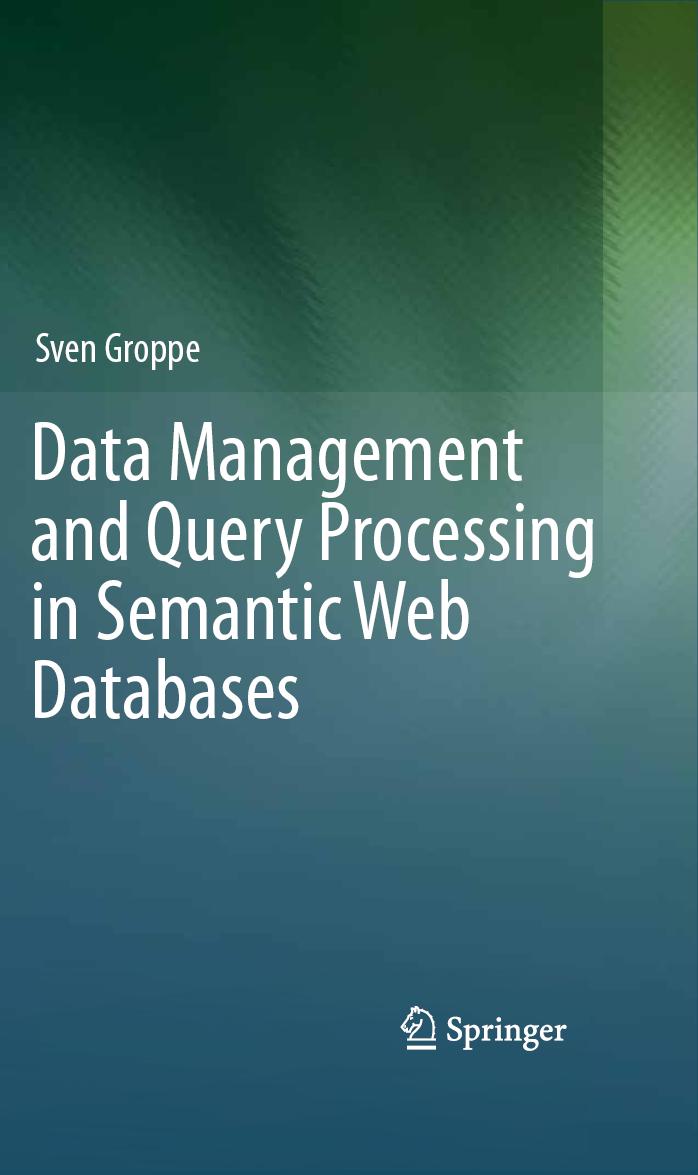
|
Data Management and Query Processing in Semantic Web Databases
|
|---|
This webpage contains additional material like exercises and their solutions for the book "Data Management and Query Processing in Semantic Web Databases".
- Author:
- Privatdozent Dr. rer. nat. habil. S. Groppe
- ISBN:
- 978-3-642-19356-9
- Book Page at Springer:
- http://www.springer.com/978-3-642-19356-9
- About the Book:
-
The Semantic Web, which is intended to establish a machine-understandable Web, is currently changing from being an emerging trend to a technology used in complex real-world applications. A number of standards and techniques have been developed by the World Wide Web Consortium (W3C), e.g., the Resource Description Framework (RDF), which provides a general method for conceptual descriptions for Web resources, and SPARQL, an RDF querying language. Recent examples of large RDF data with billions of facts include the UniProt comprehensive catalog of protein sequence, function and annotation data, the RDF data extracted from Wikipedia, and Princeton University's WordNet. Clearly, querying performance has become a key issue for Semantic Web applications.
In his book, Groppe details various aspects of high-performance Semantic Web data management and query processing. His presentation fills the gap between Semantic Web and database books, which either fail to take into account the performance issues of large-scale data management or fail to exploit the special properties of Semantic Web data models and queries. After a general introduction to the relevant Semantic Web standards, he presents specialized indexing and sorting algorithms, adapted approaches for logical and physical query optimization, optimization possibilities when using the parallel database technologies of today's multicore processors, and visual and embedded query languages.
Groppe primarily targets researchers, students, and developers of large-scale Semantic Web applications.
- Brief Table of Contents:
-
- Introduction
- Semantic Web
- External Sorting and B+-Trees
- Query Processing Overview
- Logical Optimization
- Physical Optimization
- Streams
- Parallel Databases
- Inference
- Visual Query Languages
- Embedded Languages
- Comparson of the XML and Semantic Web Worlds
- Summary, Conclusions and Future Work
- SPARQL Evaluator:
-
The SPARQL evaluator LUPOSDATE is online available at http://www.ifis.uni-luebeck.de/index.php?id=luposdate-demo.
The source code is available at https://github.com/luposdate/luposdate.
This online demonstration visualizes nearly every step of SPARQL query evaluation like the abstract syntax tree of a given query, its operatorgraph, logical and physical optimization and the evaluation of the SPARQL queries and inference.
Furthermore, the queries and data can be visually edited besides the textual editing options. Three introductionary videos explain the usage of the online demonstration.
- Exercises:
-
The following exercises complement the corresponding chapters of the book. They can be used in lectures where this book serves as course book
as well as by those who study themselves the topics of this book to deepen and to check the understanding of the described models, concepts and approaches.
| Chapter | Title | Exercises | Solutions |
|---|
| 1 | Introduction | - | - |
|---|
| 2 | Semantic Web | PDF | PDF |
|---|
| 3 | External Sorting and B+-trees | PDF | PDF |
|---|
| 4 | Query Processing Overview | PDF | PDF |
|---|
| 5 | Logical Optimization | PDF | PDF |
|---|
| 6 | Physical Optimization | PDF | PDF |
|---|
| 7 | Streams | PDF | PDF |
|---|
| 8 | Parallel Databases | PDF | PDF |
|---|
| 9 | Inference | PDF | PDF |
|---|
| 10 | Visual Query Languages | PDF | PDF |
|---|
| 11 | Embedded Languages | PDF | PDF |
|---|
| 12 | Comparison of the XML and Semantic Web Worlds | PDF | PDF |
|---|
| 13 | Summary, Conclusions and Future Work | - | - |
|---|